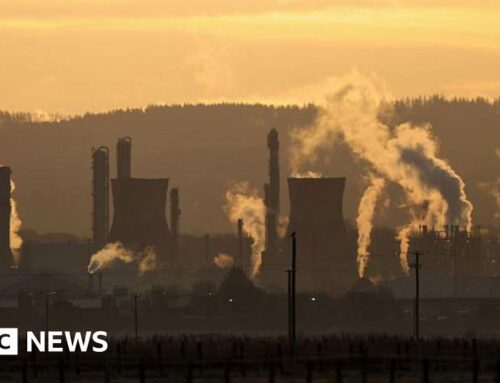Why Are Apple, Microsoft, and Tesla Stocks Going Down? Trump Tariffs Shake Tech Giants
April 8, 2025
On Monday,
April 7, 2025, the U.S. stock market showed signs of stabilization after a
volatile week triggered by President Donald Trump’s aggressive tariff policies.
However, three tech giants—Apple, Microsoft, and Tesla—continued to slide,
testing multi-month lows and shedding significant value.
The Dow
Jones Industrial Average fell 349 points, while the Nasdaq Composite eked out a
0.1% gain after a 10% plunge the prior week—its worst since March 2020. Amid
this turbulence, Apple, Microsoft, and Tesla were the only “Magnificent Seven”
stocks to decline on Monday, spotlighting the unique pressures these companies
face.
This
article explores why Apple, Microsoft, and Tesla stocks fell and provides
updated price data and analyst predictions to inform your next steps.
President
Trump’s tariff policy, enacted in early April 2025, imposes a sweeping 54% duty
on imports from China—America’s second-largest trading partner—alongside 26%
tariffs on India and 46% on Vietnam. Announced on April 2 in the White House
Rose Garden as part of a “Liberation Day” strategy, these measures aim to
bolster U.S. manufacturing but have ignited fears of a global trade war.
The
tariffs, effective from April 9, target key sectors like technology and
automotive, threatening to disrupt supply chains and inflate consumer prices.
Retaliatory threats from China, the EU (20% on U.S. imports), and Canada (25%
on U.S. vehicles) have further clouded the economic outlook.
On Monday,
April 7, Wall Street’s main indexes reflected this unease. The Dow Jones
Industrial Average dropped 349 points, or 0.82%, closing at 42,576.73, driven
by losses in tariff-sensitive industrials and tech. The S&P 500 fell 0.47%
to 5,645.23, erasing earlier gains as investors weighed tariff fallout against
a stabilizing broader market.

Meanwhile,
the Nasdaq Composite bucked the trend, edging up 0.1% to 17,987.25, buoyed by
late-day buying in select tech stocks despite declines in Apple, Microsoft, and
Tesla.
This mixed
performance underscores the market’s struggle to digest Trump’s policies, with
the Nasdaq’s prior 10% weekly loss signaling deeper tech-sector vulnerability.
However, on
Tuesday, April 8, 2025, futures for the major indexes are rebounding. S&P
500 Futures are up 1.4% to 5,167, Nasdaq 100 Futures are gaining 1.3% and stand
at 17,799, while Dow Jones Futures are rising 1.8% to 38,846.
You may also like: Will Bitcoin Crash? New BTC Price Prediction Targets $52K After Trump’s Tariffs
Why Is Apple Stock Down? A
Tariff-Induced Storm
Apple’s
stock (NASDAQ: AAPL) closed at $181.46 on Monday, April 7, down 3.67% from its
previous close of $188.38, capping a brutal three-day stretch where it lost
nearly 20% of its value—wiping out $638 billion in market capitalization.
Analysts
attribute this plunge to Trump’s tariffs, given Apple’s reliance on China,
where 90% of iPhones are assembled. The 54% tariff on Chinese imports threatens
to inflate costs significantly. Apple’s efforts to diversify production to
India, Vietnam, and Thailand offer little respite, with those countries facing
tariffs of 26% and 46%, respectively.
Analysts
present two scenarios: Apple could raise prices—UBS estimates a $350 hike for
the $1,199 iPhone 16 Pro Max—or absorb the costs, cutting into margins.
Barclays’ Tim Long warns of a potential 15% earnings-per-share hit if prices
remain static. Real-world example: A price jump to $1,549 could deter upgrades,
reducing demand—a textbook supply-and-demand shift.
|
Date |
Closing Price |
% Change |
Market Cap (Billions) |
Market Cap Change (Billions) |
|
April 7, 2025 |
$181.46 |
-3.67% |
$2,726 |
-$79 (1-day) / -$638 (3-day) |
Technical Analysis for
Apple
As my
technical analysis shows, Apple’s declines have halted at the upward gap from
early May, which currently serves as a key support level. Two major resistance
zones are emerging at $196–$200, where the highs from the turn of 2023 and 2024
are located.
The $209
level also appears significant, marking the March lows and the lower boundary
of the downward gap from early April. Only a return above this level would
renew my confidence in Apple’s potential for stronger gains and a move back
toward $260.

Why Is Microsoft Stock
Price Falling? Collateral Damage in a Trade War
Microsoft’s
stock (NASDAQ: MSFT) closed at $357.86 on April 7, down 0.55% from $359.84, reflecting a
milder but notable decline. While less directly tied to manufacturing tariffs
than Apple, Microsoft faces indirect pressures. Its Azure cloud business relies
on global data centers, some equipped with hardware from tariff-affected
regions like China. Rising component costs could erode margins, critical for a
segment that saw 33% year-over-year growth in Q1 2025.
Moreover,
Microsoft’s enterprise clients may cut IT spending if tariffs slow global
growth. Practical use case: A corporation opting for cheaper on-premises
solutions over Azure could signal broader adoption risks. The stock hit its
lowest level November 2023, reflecting investor unease.
|
Date |
Closing Price |
% Change |
Market Cap (Billions) |
Market Cap Change (Billions) |
|
April 7, 2025 |
$357.86 |
-0.55% |
$2,661* |
-$15 (1-day) |
Technical Analysis for
Microsoft
What does
the technical situation look like on Microsoft’s chart? The price has clearly
drifted away from the support zone that persisted throughout 2024 around $390.
The support defined by the July 2023 highs and December 2023 lows has also
failed to hold.
At this
point, in my view, a sharper decline in Microsoft’s stock price cannot be ruled
out, potentially even toward the September lows from a few months ago around
$309.

Other also checked: Gold Falls Below $3000 as Trump’s Tariffs Trigger Global Selloff
How Low Can Tesla Go?
Tariffs and a Brand Crisis
Tesla’s
stock (NASDAQ: TSLA) closed at $233.29 on April 7, down 2.56% from $239.43, extending a
week-long slide of over 10%. Wedbush Securities’ Dan Ives calls it a “perfect
storm.” Tariffs threaten Tesla’s supply chain, with battery cells from China
facing 54% duties. Although U.S. production mitigates some risk, Tesla’s China
market—22% of revenue—faces retaliatory tariffs and competition from BYD.
Elon Musk’s
Trump alignment has also sparked a brand crisis. X posts highlight boycotts by
liberal buyers, while Ives notes “unprecedented brand damage” in China and
Europe. Real-world impact: Q1 2025 deliveries fell 13% to 336,681 units,
signaling demand erosion amid political and economic pressures.
|
Date |
Closing Price |
% Change |
Market Cap (Billions) |
Market Cap Change (Billions) |
|
April 7, 2025 |
$233.29 |
-2.56% |
$749 |
-$5 (1-day) |
Technical Analysis for
Tesla
Tesla’s
technical chart differs significantly from those of Apple and Microsoft. Why?
Primarily because the local lows from March have not been breached, and the
$220 level continues to protect the bulls from further declines.
At the
moment, I’m mainly focused on the $270 resistance, which aligns with the highs
from July, September, and October 2024, as well as the $289 level, the peak
from late March. Together with the current $220 level, this forms a range
within which Tesla’s stock price may currently fluctuate.

Analyst Price Predictions
and Recommendations
Here’s
what experts predict as of April 8, 2025:
Highlights
resilience
in
cloud
growth.
|
Company |
Analyst/Firm |
Price Target |
Rating |
Key Insights |
|
Apple |
Wedbush (Dan Ives) |
$250 |
Outperform |
Cut |
|
UBS |
$200 |
Neutral* |
Assumes |
|
|
Barclays (Tim Long) |
$190 |
Neutral |
Warns |
|
|
Microsoft |
JPMorgan |
$450 |
Overweight |
Views |
|
Morgan Stanley |
$460 |
Outperform |
||
|
Tesla |
Wedbush (Dan Ives) |
$315 |
Outperform |
Slashed |
|
JPMorgan |
$120 |
Underweight |
Bearish |
*Note:
UBS rating inferred as “Neutral” based on cautious outlook; not
explicitly stated.
Apple
- Wedbush (Dan Ives): Cut target
from $325 to $250, citing tariffs, but holds “Outperform.” - UBS: Sees $200 if prices rise
by $350, factoring in demand resilience. - Barclays (Tim Long): Neutral at
$190, warns of 15% EPS cut.
Microsoft
- JPMorgan: “Overweight” at $450,
views tariff impact as secondary. - Morgan Stanley: Targets $460,
“Outperform,” citing cloud strength.
Tesla
- Wedbush (Dan Ives): Slashed
target from $550 to $315, “Outperform,” urges brand fixes. - JPMorgan: Bearish at $120,
“Underweight,” citing deliveries and tariffs.
Key Takeaways for
Investors
The Monday
declines of Apple, Microsoft, and Tesla reflect Trump’s tariffs’ broad reach.
Apple’s China exposure, Microsoft’s indirect hits, and Tesla’s supply chain and
brand woes highlight vulnerabilities. Beginners learn geopolitical risk’s
weight; traders reassess holdings. Your technical analysis will guide
short-term moves, but long-term success depends on adaptation—price hikes,
supply shifts, or brand repair. Analyst outlooks suggest volatility ahead, yet
opportunities remain for the astute investor.
FAQ: Why Are Apple,
Microsoft, and Tesla Shares Dropping?
Why Are Apple Shares
Dropping Amid Trump’s Tariffs?
Apple
shares fell 3.67% to $181.46 on April 7, 2025, losing $638 billion in market
cap over three days. The primary reason is Trump’s 54% tariff on Chinese
imports, where 90% of iPhones are assembled. Additional tariffs on India (26%)
and Vietnam (46%)—where Apple has diversified production—exacerbate the issue.
Analysts warn Apple may raise iPhone prices by $350 or face a 15%
earnings-per-share cut, impacting investor confidence.
Why Is Microsoft Stock
Declining Despite a Broader Tech Recovery?
Microsoft’s
stock dipped 0.55% to $357.86 on April 7, 2025, despite the Nasdaq gaining
0.1%. While less exposed to direct tariffs, Microsoft faces indirect pressure
from rising costs of hardware components sourced from tariff-hit regions like
China, affecting its Azure cloud business margins. Additionally, a potential
global slowdown could lead enterprise clients to cut IT budgets, contributing
to the stock’s decline.
Why Are Tesla Shares
Falling Amid Trump’s Tariff Policies?
Tesla
shares dropped 2.56% to $233.29 on April 7, 2025, due to a “perfect storm” of
challenges. Trump’s 54% tariffs on Chinese imports impact Tesla’s battery
supply chain, while retaliatory tariffs in China—where Tesla earns 22% of
revenue—threaten sales. A brand crisis linked to Elon Musk’s alignment with
Trump has also sparked boycotts, with Q1 2025 deliveries down 13% to 336,681
units, fueling the stock’s decline.
On Monday,
April 7, 2025, the U.S. stock market showed signs of stabilization after a
volatile week triggered by President Donald Trump’s aggressive tariff policies.
However, three tech giants—Apple, Microsoft, and Tesla—continued to slide,
testing multi-month lows and shedding significant value.
The Dow
Jones Industrial Average fell 349 points, while the Nasdaq Composite eked out a
0.1% gain after a 10% plunge the prior week—its worst since March 2020. Amid
this turbulence, Apple, Microsoft, and Tesla were the only “Magnificent Seven”
stocks to decline on Monday, spotlighting the unique pressures these companies
face.
This
article explores why Apple, Microsoft, and Tesla stocks fell and provides
updated price data and analyst predictions to inform your next steps.
President
Trump’s tariff policy, enacted in early April 2025, imposes a sweeping 54% duty
on imports from China—America’s second-largest trading partner—alongside 26%
tariffs on India and 46% on Vietnam. Announced on April 2 in the White House
Rose Garden as part of a “Liberation Day” strategy, these measures aim to
bolster U.S. manufacturing but have ignited fears of a global trade war.
The
tariffs, effective from April 9, target key sectors like technology and
automotive, threatening to disrupt supply chains and inflate consumer prices.
Retaliatory threats from China, the EU (20% on U.S. imports), and Canada (25%
on U.S. vehicles) have further clouded the economic outlook.
On Monday,
April 7, Wall Street’s main indexes reflected this unease. The Dow Jones
Industrial Average dropped 349 points, or 0.82%, closing at 42,576.73, driven
by losses in tariff-sensitive industrials and tech. The S&P 500 fell 0.47%
to 5,645.23, erasing earlier gains as investors weighed tariff fallout against
a stabilizing broader market.

Meanwhile,
the Nasdaq Composite bucked the trend, edging up 0.1% to 17,987.25, buoyed by
late-day buying in select tech stocks despite declines in Apple, Microsoft, and
Tesla.
This mixed
performance underscores the market’s struggle to digest Trump’s policies, with
the Nasdaq’s prior 10% weekly loss signaling deeper tech-sector vulnerability.
However, on
Tuesday, April 8, 2025, futures for the major indexes are rebounding. S&P
500 Futures are up 1.4% to 5,167, Nasdaq 100 Futures are gaining 1.3% and stand
at 17,799, while Dow Jones Futures are rising 1.8% to 38,846.
You may also like: Will Bitcoin Crash? New BTC Price Prediction Targets $52K After Trump’s Tariffs
Why Is Apple Stock Down? A
Tariff-Induced Storm
Apple’s
stock (NASDAQ: AAPL) closed at $181.46 on Monday, April 7, down 3.67% from its
previous close of $188.38, capping a brutal three-day stretch where it lost
nearly 20% of its value—wiping out $638 billion in market capitalization.
Analysts
attribute this plunge to Trump’s tariffs, given Apple’s reliance on China,
where 90% of iPhones are assembled. The 54% tariff on Chinese imports threatens
to inflate costs significantly. Apple’s efforts to diversify production to
India, Vietnam, and Thailand offer little respite, with those countries facing
tariffs of 26% and 46%, respectively.
Analysts
present two scenarios: Apple could raise prices—UBS estimates a $350 hike for
the $1,199 iPhone 16 Pro Max—or absorb the costs, cutting into margins.
Barclays’ Tim Long warns of a potential 15% earnings-per-share hit if prices
remain static. Real-world example: A price jump to $1,549 could deter upgrades,
reducing demand—a textbook supply-and-demand shift.
|
Date |
Closing Price |
% Change |
Market Cap (Billions) |
Market Cap Change (Billions) |
|
April 7, 2025 |
$181.46 |
-3.67% |
$2,726 |
-$79 (1-day) / -$638 (3-day) |
Technical Analysis for
Apple
As my
technical analysis shows, Apple’s declines have halted at the upward gap from
early May, which currently serves as a key support level. Two major resistance
zones are emerging at $196–$200, where the highs from the turn of 2023 and 2024
are located.
The $209
level also appears significant, marking the March lows and the lower boundary
of the downward gap from early April. Only a return above this level would
renew my confidence in Apple’s potential for stronger gains and a move back
toward $260.

Why Is Microsoft Stock
Price Falling? Collateral Damage in a Trade War
Microsoft’s
stock (NASDAQ: MSFT) closed at $357.86 on April 7, down 0.55% from $359.84, reflecting a
milder but notable decline. While less directly tied to manufacturing tariffs
than Apple, Microsoft faces indirect pressures. Its Azure cloud business relies
on global data centers, some equipped with hardware from tariff-affected
regions like China. Rising component costs could erode margins, critical for a
segment that saw 33% year-over-year growth in Q1 2025.
Moreover,
Microsoft’s enterprise clients may cut IT spending if tariffs slow global
growth. Practical use case: A corporation opting for cheaper on-premises
solutions over Azure could signal broader adoption risks. The stock hit its
lowest level November 2023, reflecting investor unease.
|
Date |
Closing Price |
% Change |
Market Cap (Billions) |
Market Cap Change (Billions) |
|
April 7, 2025 |
$357.86 |
-0.55% |
$2,661* |
-$15 (1-day) |
Technical Analysis for
Microsoft
What does
the technical situation look like on Microsoft’s chart? The price has clearly
drifted away from the support zone that persisted throughout 2024 around $390.
The support defined by the July 2023 highs and December 2023 lows has also
failed to hold.
At this
point, in my view, a sharper decline in Microsoft’s stock price cannot be ruled
out, potentially even toward the September lows from a few months ago around
$309.

Other also checked: Gold Falls Below $3000 as Trump’s Tariffs Trigger Global Selloff
How Low Can Tesla Go?
Tariffs and a Brand Crisis
Tesla’s
stock (NASDAQ: TSLA) closed at $233.29 on April 7, down 2.56% from $239.43, extending a
week-long slide of over 10%. Wedbush Securities’ Dan Ives calls it a “perfect
storm.” Tariffs threaten Tesla’s supply chain, with battery cells from China
facing 54% duties. Although U.S. production mitigates some risk, Tesla’s China
market—22% of revenue—faces retaliatory tariffs and competition from BYD.
Elon Musk’s
Trump alignment has also sparked a brand crisis. X posts highlight boycotts by
liberal buyers, while Ives notes “unprecedented brand damage” in China and
Europe. Real-world impact: Q1 2025 deliveries fell 13% to 336,681 units,
signaling demand erosion amid political and economic pressures.
|
Date |
Closing Price |
% Change |
Market Cap (Billions) |
Market Cap Change (Billions) |
|
April 7, 2025 |
$233.29 |
-2.56% |
$749 |
-$5 (1-day) |
Technical Analysis for
Tesla
Tesla’s
technical chart differs significantly from those of Apple and Microsoft. Why?
Primarily because the local lows from March have not been breached, and the
$220 level continues to protect the bulls from further declines.
At the
moment, I’m mainly focused on the $270 resistance, which aligns with the highs
from July, September, and October 2024, as well as the $289 level, the peak
from late March. Together with the current $220 level, this forms a range
within which Tesla’s stock price may currently fluctuate.

Analyst Price Predictions
and Recommendations
Here’s
what experts predict as of April 8, 2025:
Highlights
resilience
in
cloud
growth.
|
Company |
Analyst/Firm |
Price Target |
Rating |
Key Insights |
|
Apple |
Wedbush (Dan Ives) |
$250 |
Outperform |
Cut |
|
UBS |
$200 |
Neutral* |
Assumes |
|
|
Barclays (Tim Long) |
$190 |
Neutral |
Warns |
|
|
Microsoft |
JPMorgan |
$450 |
Overweight |
Views |
|
Morgan Stanley |
$460 |
Outperform |
||
|
Tesla |
Wedbush (Dan Ives) |
$315 |
Outperform |
Slashed |
|
JPMorgan |
$120 |
Underweight |
Bearish |
*Note:
UBS rating inferred as “Neutral” based on cautious outlook; not
explicitly stated.
Apple
- Wedbush (Dan Ives): Cut target
from $325 to $250, citing tariffs, but holds “Outperform.” - UBS: Sees $200 if prices rise
by $350, factoring in demand resilience. - Barclays (Tim Long): Neutral at
$190, warns of 15% EPS cut.
Microsoft
- JPMorgan: “Overweight” at $450,
views tariff impact as secondary. - Morgan Stanley: Targets $460,
“Outperform,” citing cloud strength.
Tesla
- Wedbush (Dan Ives): Slashed
target from $550 to $315, “Outperform,” urges brand fixes. - JPMorgan: Bearish at $120,
“Underweight,” citing deliveries and tariffs.
Key Takeaways for
Investors
The Monday
declines of Apple, Microsoft, and Tesla reflect Trump’s tariffs’ broad reach.
Apple’s China exposure, Microsoft’s indirect hits, and Tesla’s supply chain and
brand woes highlight vulnerabilities. Beginners learn geopolitical risk’s
weight; traders reassess holdings. Your technical analysis will guide
short-term moves, but long-term success depends on adaptation—price hikes,
supply shifts, or brand repair. Analyst outlooks suggest volatility ahead, yet
opportunities remain for the astute investor.
FAQ: Why Are Apple,
Microsoft, and Tesla Shares Dropping?
Why Are Apple Shares
Dropping Amid Trump’s Tariffs?
Apple
shares fell 3.67% to $181.46 on April 7, 2025, losing $638 billion in market
cap over three days. The primary reason is Trump’s 54% tariff on Chinese
imports, where 90% of iPhones are assembled. Additional tariffs on India (26%)
and Vietnam (46%)—where Apple has diversified production—exacerbate the issue.
Analysts warn Apple may raise iPhone prices by $350 or face a 15%
earnings-per-share cut, impacting investor confidence.
Why Is Microsoft Stock
Declining Despite a Broader Tech Recovery?
Microsoft’s
stock dipped 0.55% to $357.86 on April 7, 2025, despite the Nasdaq gaining
0.1%. While less exposed to direct tariffs, Microsoft faces indirect pressure
from rising costs of hardware components sourced from tariff-hit regions like
China, affecting its Azure cloud business margins. Additionally, a potential
global slowdown could lead enterprise clients to cut IT budgets, contributing
to the stock’s decline.
Why Are Tesla Shares
Falling Amid Trump’s Tariff Policies?
Tesla
shares dropped 2.56% to $233.29 on April 7, 2025, due to a “perfect storm” of
challenges. Trump’s 54% tariffs on Chinese imports impact Tesla’s battery
supply chain, while retaliatory tariffs in China—where Tesla earns 22% of
revenue—threaten sales. A brand crisis linked to Elon Musk’s alignment with
Trump has also sparked boycotts, with Q1 2025 deliveries down 13% to 336,681
units, fueling the stock’s decline.
Search
RECENT PRESS RELEASES
Risk-loving Korean investors made to watch training video before trading
SWI Editorial Staff2025-12-13T19:23:06-08:00December 13, 2025|
Pinnapuram Integrated Renewable Energy Project transforms barren land into world’s largest
SWI Editorial Staff2025-12-13T18:20:39-08:00December 13, 2025|
Athena Bitcoin Highlights the Power of Decentralization as the World Reflects on Satoshi N
SWI Editorial Staff2025-12-13T18:19:37-08:00December 13, 2025|
Investing in Our Communities: Northern New Jersey Community Foundation presents Grant Awar
SWI Editorial Staff2025-12-13T18:09:12-08:00December 13, 2025|
Greed vs. fear at $3K: Inside Ethereum’s make-or-break moment
SWI Editorial Staff2025-12-13T16:17:52-08:00December 13, 2025|
Weather alerts issued across much of Canada as winter approaches
SWI Editorial Staff2025-12-13T16:08:31-08:00December 13, 2025|
Related Post




